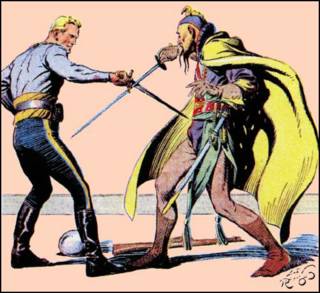
In 1934 Alex Raymond forever changed the "comic world" when he created a new comic strip character to compete with the extremely popular Buck Rogers comic strip. Flash Gordon offered all the excitement of the typical Buck Rogers adventure, but with two significant improvements. First, Raymond's art was far superior to that of the Rogers title and was better able to transate the excitement of "cliffhanging adventure." Second, the Flash Gordon universe was more fantastic that scientific. Buck Rogers as a title has always demanded a modicum of scientific plausibility, but Flash Gordon has never had such limitations. Flash was truly the adventures of the mind.
Not surprisingly Raymond's influence has extended into modern movies as well. A Gordon comic fan cannot help but see honest homage to Raymond's creation when he watches the Star Wars films. Both contain "moving planets" (Mongo vs. the Death Star), evil emperors (Ming vs. Palpatine), princesses (Aura vs. Leia), anthropomorphic animistic friends (Thun the Lion Man vs. Chewbacca the Wookie), roguish allies (Prince Barin vs. Han Solo. The list of comparisons above is far from exhaustive and is not meant to detract from Star Wars in any way. Star Wars easily deserves its place beside Raymond's creation, but the influence of Flash Gordon on a young Lucas is almost undeniable. One of the reasons for the enduring legacy of Raymond's creation was his attitude toward the medium itself:
I decided honestly that comic art is an art form in itself. It reflects the life and times more accurately and actually is more artistic than magazine illustration -- since it is entirely creative. An illustrator works with camera and models; a comic artist begins with a white sheet of paper and dreams up his own business -- he is playwright, director, editor, and artist at once.
It was with great excitement that I entered the comic shop yesterday, because the Third Volume in a series of collected editions by Checker Book Publishing was released this week. This particular volume features strips running from October 25, 1936 to June 5, 1938 and includes four exciting story arcs. Checker Books have planned two more volumes in the series and I eagerly await those as well.
Rather than bore you with specifics, I think I will let the art speak for itself today.




No comments:
Post a Comment